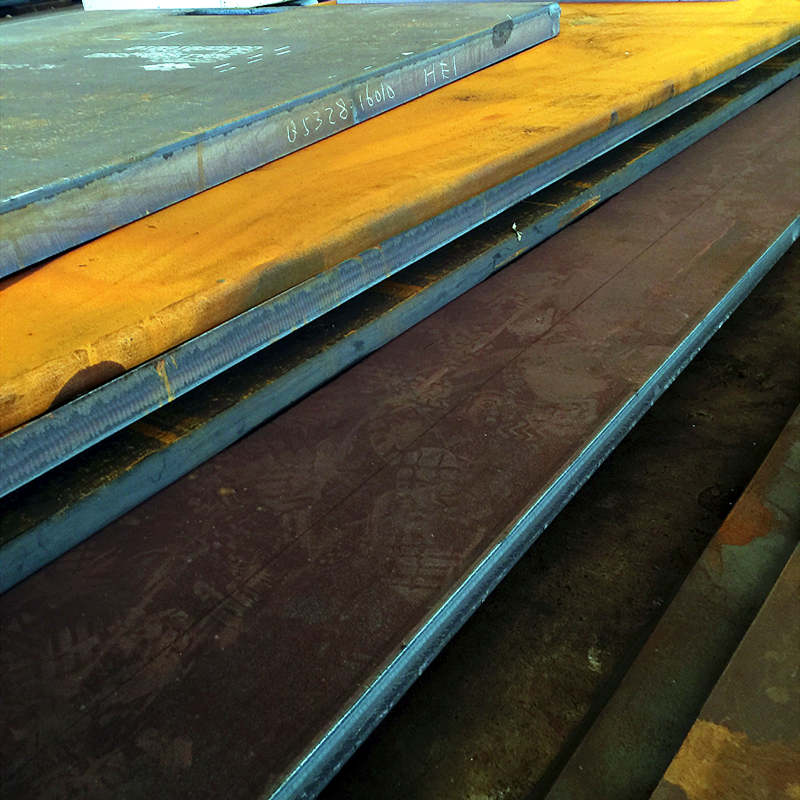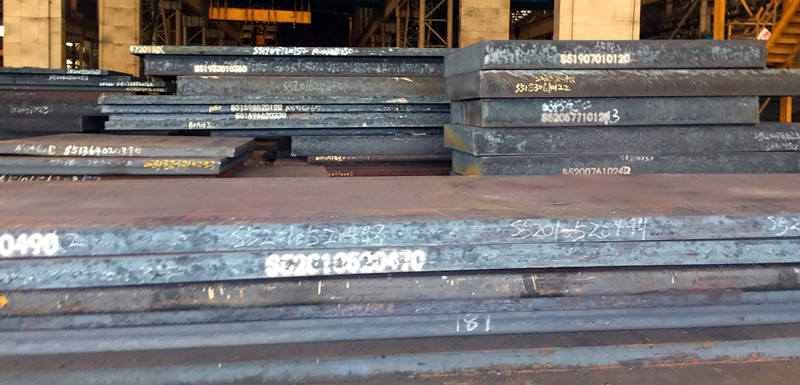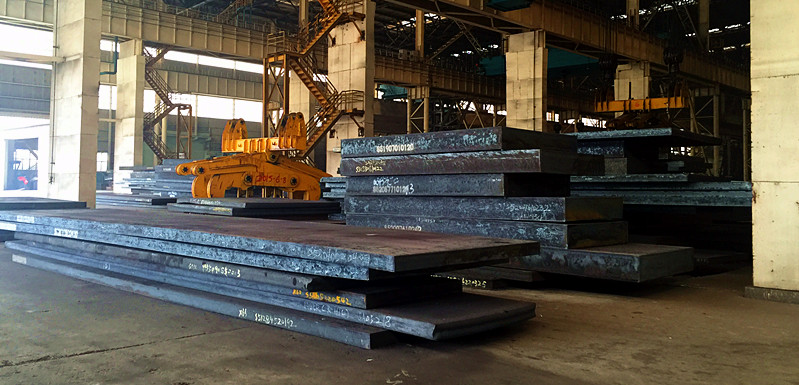
NM500 Steel Plate Project
Application: NM500 wear-resistant steel plates are widely used in engineering machinery.
NM500 STEEL PLATE definition
Naming: N is the first pinyin letter of "resistant" in "wearable".
M is the first pinyin letter of "grinding" in "wear resistance".
500 is the HB value of Brinell hardness.
(The hardness value of 500 is broad, and the hardness value of domestic NM500 is around 500.)
NM500 is a high-strength wear-resistant steel plate with high wear resistance. The Brinell hardness value of 500 (HBW) is mainly to provide protection on occasions or parts where wear resistance is required so that the equipment has a longer life and reduces maintenance.


NM500 STEEL PLATE Wear-resistant steel plate processing
1. The steel plate cutting method is suitable for cold cutting and hot cutting.
Cold cutting includes water jet cutting, shearing, sawing, or abrasive cutting; hot cutting includes oxygen fuel flame cutting (hereinafter referred to as “flame cutting”), plasma cutting and laser cutting.
2. Cutting method: Through relevant process tests, master the general characteristics and cutting thickness range of various cutting methods of steel plates.
3. The flame cutting method of high-grade wear-resistant steel is as simple as that of ordinary low-carbon and low-alloy steel. When cutting thick plates of wear-resistant steel, you need to pay attention!
As the thickness and hardness of the steel plate increase, the cracking tendency of the cutting edge increases.
In order to prevent the occurrence of steel plate cutting cracks, the following suggestions should be followed when cutting:
Cutting crack: The cutting crack of the steel plate is similar to the hydrogen-induced cracking during welding. If the steel plate is cracked at the cutting edge, it will appear within 48 hours to several weeks of the cutting thickness.
Therefore, the cutting crack is a delayed crack, the greater the thickness and hardness of the steel plate, the greater the occurrence of cutting cracks.
Preheating cutting: The most effective way to prevent steel plate cutting cracks is to preheat before cutting.
Before flame cutting, the steel plate is usually preheated. The preheating temperature is mainly determined by the quality grade and thickness of the steel plate. See Table 2. The preheating method can be carried out by flame burner, electronic heating pad, or can be used.
Heating furnace.
In order to determine the preheating effect of the steel plate, the required temperature should be tested at the heating point.
Note: Special attention should be paid to the preheating, so that the interface of the steel plate is heated uniformly to avoid local overheating in the area contacting the heat source.
Low speed cutting: Another way to avoid cutting cracks is to reduce the cutting speed.
If full-page preheating is not possible, local preheating can be used instead.
Using low-speed cutting methods to prevent cutting cracks, its reliability is not as good as preheating.
We recommend pre-heating the cutting tape with a flame gun for several passes before cutting. The preheating temperature should be around 100°C.
The maximum cutting speed depends on the steel plate grade and thickness
Special note: the combination of preheating and low-speed flame cutting methods can further reduce the chance of cutting cracks.
Slow cooling requirements after cutting: Regardless of whether the cutting is preheated or not, the slow cooling after cutting the steel plate will effectively reduce the risk of cutting cracks.
If it is stacked after being cut with warm heat, cover it with an insulating blanket to achieve slow cooling, which requires cooling to room temperature.
Heating requirements after cutting: For cutting of wear-resistant steel plates, heating (low-temperature tempering) immediately after cutting is also an effective method and measure to prevent cutting cracks.
The thickness of the steel plate can be effectively eliminated by low-temperature tempering treatment (low-temperature tempering process; moisture retention time is 5min/mm)
For the method of heating after cutting, the heating method of the burning gun, electronic heating blanket, and heat-saving furnace are also used for heating after cutting.
4. Measures to reduce the softening of the steel plate The anti-softening characteristics of steel mainly depend on its chemical composition, microstructure, and processing method.
For hot-cut parts, the smaller the part, the greater the risk of softening the entire part.
If the temperature of the steel plate exceeds 200-250°C, the hardness of the steel plate will decrease.
Cutting method: When the steel plate is cutting small parts, the heat supplied by the welding torch and preheating will accumulate in the workpiece.
The smaller the cutting size, the smaller the cutting workpiece size should be at least 200mm, otherwise, the workpiece will be at risk of softening.
The best way to eliminate the risk of softening is cold cutting, such as water jet cutting.
If thermal cutting is necessary, plasma or laser cutting is limited.
This is because flame cutting provides more heat to the workpiece, thus increasing the temperature of the workpiece.
Underwater cutting method: an effective method to limit and reduce the range of the softening zone, use water to cut the steel plate and the cutting surface during the cutting process.
Therefore, the steel plate can be cut in water or sprayed to the cutting surface for cutting.
Using the underwater cutting method can choose plasma or flame cutting.
Underwater cutting has the following characteristics:
The cutting heat affected zone is small;
Prevent the hardness of the entire workpiece from decreasing;
Reduce the deformation of the cutting workpiece;

Nm360 steel data sheet supplier
Nm360 steel data sheet supplier We have 3000tons NM360 stock steel plate and are specialized in NM360 steel plate thickness […]

Nm400 steel plate supplier
We are Nm400 steel plate stock supplier We have 3000tons NM400 stock steel plate and are specialized in NM40 […]

Nm450 steel plate data sheet supplier
Nm450 steel plate data sheet supplier We have 3000tons NM450 stock steel plate and are specialized in NM450 steel plate […]

Nm500 steel plate supplier
Nm500 steel plate supplier We have 3000tons NM500 stock steel plate and are specialized in NM500 steel plate thickness […]

ASTM A203GR.A Nickel-Alloy steel plate
ASTM A203GR.A Nickel-Alloy steel plate United steel export ASTM A203/A203M Nickel-Alloy steel plate of A203GR.A,ASTM A203GR.A,A203GR.A Steel,A203GR.A HIC,A203GR.A NACE […]

ASTM A203GR.B Nickel-Alloy steel plate
ASTM A203GR.B Nickel-Alloy steel plate United steel export ASTM A203/A203M heavy plate and wide, Nickel-Alloy steel plate A203GR.B, ASTM A203GR.B, […]

ASME A203GR.D Nickel-Alloy steel plate
ASME A203GR.D Nickel-Alloy steel plate United steel export ASTM A203/A203M heavy plate and wide, Nickel-Alloy steel plate A203GR.D, ASME […]

